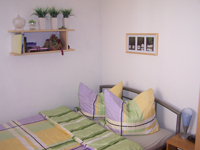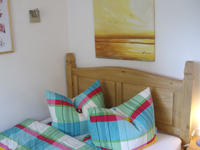With Fewo Köln in: Bayenthal

The district of Bayenthal is geographically located in the south of Cologne and has district number 201. Adjacent districts are: Marienburg , Poll , Neustadt Süd and Raderberg . "Father Rhine" also borders Bayenthal.
| District number | Area | Inhabitants |
| 201 | 1.28 square kilometers | 10,000 |
History of Bayenthal
The district was first mentioned in a tradition from 1307. However, a real development as a place or district only took place from 1856 onwards. In the period from 1830 to 1856 Bayenthal consisted of only three houses! But when the company "Kölnnic Maschinenbau AG" settled down, the place developed into an industrial location. Many workers' houses were built and the population began to grow. In 1888 it was incorporated into Cologne. Immediately a horse-drawn tram was built, which connected the place with the inner city of Cologne. Bayenthal officially became part of the Cologne-Rodenkirchen district in 1975.
.gif)
.gif)
.gif)
.gif)
.gif)
.gif)
.gif)
.gif)
.gif)
.gif)
Kölnische Maschinenbau-AG
Kölnische Maschinenbau-AG was an existing mechanical engineering company between the years 1856 and 1909. The company was located in Cologne Bayenthal. It was continued by other companies until the 1970s. After all, the name had a lot to do with the industry. The Cologne company was founded in 1856 by the engineer Martin Goltstein and the businessman Gustav Mevissen. What a wise decision. The company built machines for mining as well as for metalworks, steam boilers, steam turbines, gas machines, gasometers, bridges and other railway constructions. So you can find the products everywhere. The number of employees has already reached 1500 people. So a great employer. For the 3 large railway companies in the Rhineland, the company sometimes carried out large orders. That worked pretty well.
In the years 1866 and also in 1867, due to the withdrawal of Mevissen and the death of Goltstein at the beginning of 1867, the construction of bridges was abandoned, which was considered risky as well as deficit. One reason was the growing competition with the very close entrepreneurial ties to the metallurgical industry. To break free here was the goal. In May 1909, the well-known banking house Levy & Co brokered the merger with Berlin-Anhalt Maschinenbau AG. Quite a household name. So the Cologne plant lived on. In 1924, BAMAG merged with Bamag Meguin AG. The further development of Kölnische Maschinenbau-AG resulted in a very large industrial area between Bonner Strasse and the Rhine. You can hardly miss it. The first plants, including the foundry that went into operation in March 1858, were located between the Rhine and Alteburger Strasse. A whole complex slowly emerged. On the other side of the street was the engineering center of the factory with a design office. Many a bold construction was created here.
.gif)
.gif)
.gif)
.gif)
.gif)
.gif)
.gif)
.gif)
.gif)
.gif)
Later on, more and more halls and other facilities were built behind it, although in the end the actual part of the business was located between Alteburger, Tacitus and Goltsteinstrasse. So everything is pretty close together. In 1888 the plant had the departments of gas container factory, iron foundry, iron construction works, pipe foundry, steam boiler factory and mechanical engineering workshop. What you just needed. The 1st mechanical engineering workshop was destroyed by a serious fire in 1883. That could happen in the industry. In 1898 a hurricane caused considerable damage. Very annoying by the way. Workers' houses were built on Alteburger Strasse very early on for non-local skilled workers, some of which have still been preserved. They still convey something of the flair of that time. A villa was built for the director of the company. Despite the great damage caused by World War II, the structure of the plant was largely preserved. only the front facing Alteburger Strasse got a new face. So much remained as before. After the factory was closed in 1970, the site was completely cleared and the well-known architects Fischer, Rathai and Krüder provided a residential complex until 1977.
Holiday apartment Cologne tip
The Apartment Cologne recommends a walk along the Rhine! When the weather is nice, a visit to the ice cream parlor is a nice thing!
.gif)
.gif)
.gif)
.gif)
.gif)
.gif)
.gif)
.gif)
.gif)
.gif)
Buildings and facilities
The parish church of St. Matthias was built on Matthias Church Square. Masses are now taking place there and the church has space for around 1,600 believers. The St. Antonius Hospital was also built and a rectory near the church. Since the war caused severe damage to the buildings, they had to be rebuilt after the Second World War. This was used at the same time to design the premises. A newly designed church interior was inaugurated in July 1952, for example. Other interesting or important buildings are:
- the old post office Mathiaskirchplatz
- Antonius Hospital with a chapel with a special, copper-plated roof turret
- the St. Josefhaus dormitory in Bernhardstrasse, which has been a memorial since February 28, 1985
- Archbishop's Irmgardis-Gymnasium Cologne
- the flood pumping station directly on the banks of the Rhine in Schönhauser Strasse
.gif)
.gif)
.gif)
.gif)
.gif)
.gif)
.gif)
.gif)
.gif)
.gif)
.gif)
.gif)
.gif)
.gif)
.gif)
.gif)
.gif)
.gif)
.gif)
.gif)
.gif)
.gif)
.gif)
.gif)
.gif)
.gif)
.gif)
.gif)
.gif)
.gif)
.gif)
.gif)
.gif)
.gif)
.gif)
.gif)
.gif)
Economy and Transport
As already mentioned above, the city or the district of Bayenthal developed into an industrial location in its early years, which housed some companies that simply could not find a place in the much too narrow inner city. In 1864 the "Kölnische Maschinenbau AG" already had more than 1500 employees! The following articles were built or produced:
- Operating and blower machines
- Steam boiler
- Bridges
- Steam engines
- Gas engines
- all iron structures that were used
- Roof constructions for Cologne Central Station, the beautiful flora or even for our cathedral the Cologne Cathedral
After the merger and ultimately then closure.

Book a Apartment Cologne with us with the Weihofen family! Take a look at our guest book: Only satisfied guests at Apartment Cologne !



